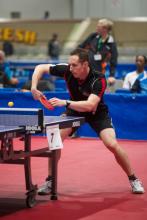Attacking Short/Half-Long Balls
-By Samson Dubina
US Nationals Online Entry: http://www.teamusa.org/USA-Table-Tennis/2017-US-Nationals
Previous US Nationals Article: http://www.samsondubina.com/coaching/playing-high-altitudes
I realize that many of you will be competing in the US Nationals this July in Las Vegas. Last week, I wrote an article giving you seven keys to playing in high altitudes. This week, I’m going to focus more narrowly on one of those aspects: Half-Long Balls.
Because the air is thinner in Las Vegas (due to the altitude), the ball travels slightly deeper. When you serve short and your opponent pushes short, it might actually be a slightly longer push. There are many in-between balls that can actually be looped (see video below)!!! So how is your technique going to be the same or different if their push floats out a bit?
If you watch videos from the 1980’s you will see a very clear distinction between flipping and looping. It’s almost like there is an invisible wall that blocks the players from looping over the table. Now in the year 2017, there is almost a blurring of the lines between the flip and loop, the loop can often be performed over-the-table, especially on the backhand side. With the proper footwork, body positioning, and wrist action, the backhand flip and loop can be performed against the short push, medium push, and long push with a similar racket angle of about 30 degrees, a similar backswing, and similar followthrough. If you are trying to backhand flip the short push and it leaks out, then simply wait a split second longer before looping. If you are trying to backhand flip the long push and it is a bit shorter, then simply step forward with the right foot, lean forward, and attack over the table. As I mentioned, the actual stroke itself looks very similar.
The forehand is a bit different because the forehand flip has a more limited range of motion, it limits the amount of spin that you can impart. With less spin, the angle needs to be slightly more open (about 90 degrees) to attack the backspin ball. With more spin on the forehand loop, you can be slightly more closed when looping the half-long push with your forehand. Also, when the ball is very short to the forehand, make sure that you step forward, turn your shoulders a bit – this allows you a full range of motion to flip anywhere on the table. Turning the shoulders is also important when looping the half-long push as well, as it helps with timing and racket speed.
Closing Comments
1. Remember that many in-between balls can actually be looped over-the-table
2. Keep the feet parallel to the table when attacking half-long push
3. Step forward slightly with the right foot when attacking the short push
4. Take the wrist back and low for the backhand flip and loop
5. Open the angle for the forehand flip
6. Turn the shoulders for both the forehand flip and loop




